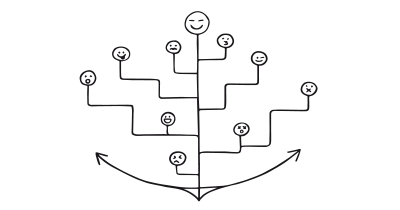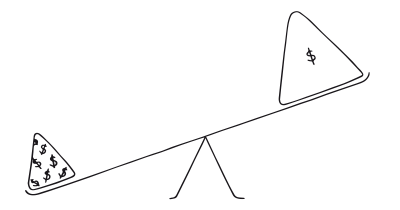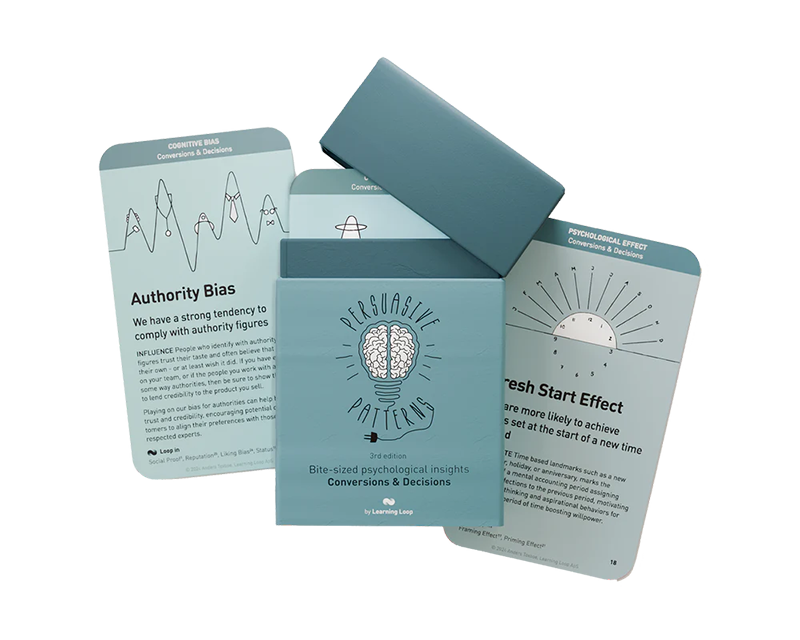Persuasive Patterns: Obligation
Reputation
We adjust our personal behavior to reflect how we are perceived by others

Reputation refers to the collective perception or assessment of an entity’s credibility, quality, and reliability based on past actions or outcomes.
Imagine walking into a bustling marketplace. You’re on the hunt for a handcrafted leather bag. Two stalls catch your eye. The first stall has a vendor who’s surrounded by a crowd of people. You overhear snippets of conversations where customers are praising the vendor for the quality of his goods and his fair dealings in the past. The second stall, however, has a vendor with only a few customers. You overhear a couple of them whispering about a friend who had a not-so-great experience with the vendor’s products.
Given the reputation of the two vendors, you’re naturally inclined to trust the first vendor more. The positive word-of-mouth acts as a powerful endorsement, making you more confident in your decision to purchase from him.
Now, think of an online platform where you’re looking to buy a vintage camera. Two sellers have the exact model you want. The first seller has a 98% positive feedback score with hundreds of reviews praising the product quality and swift delivery. Comments mention previous successful transactions and the trustworthiness of the seller. The second seller, however, has an 85% positive feedback score with a few buyers mentioning delays in delivery and lack of communication.
Much like the marketplace scenario, you’re more likely to buy from the first seller on the online platform. The digital reputation, represented by feedback scores and reviews, guides your decision, making you feel more secure in your purchase.
The study
In a pivotal study on peer-to-peer online markets, Jiao, Przepiorka, and Buskens (2021) explored the influence of reputation systems, where traders rate each other’s behaviors. Their meta-analysis of 107 studies revealed that sellers with higher reputation scores had a distinct advantage, with a median effect size of 0.26. This advantage was even more pronounced in high-stakes markets, with the effect size rising to 0.34 for transactions above $100. However, in highly competitive markets, the reputation effect slightly diminished. These findings underscore the crucial role of reputation in online consumer decisions, emphasizing the need for transparency and ethical considerations in reputation management.
Jiao, R., Przepiorka, W., & Buskens, V. (2021). Reputation effects in peer-to-peer online markets: A meta-analysis∗. Social science research, 95, 102522.
Reputation is a powerful determinant in influencing decisions and behaviors. It acts as a heuristic or shortcut for individuals when making choices, especially in situations with limited information or time. A strong reputation can instill trust, reduce perceived risks, and enhance the perceived value of a product or service. Conversely, a negative reputation can deter potential users or customers. Given its influential nature, reputation management has become a focal point for businesses and individuals alike.
Designing products using Reputation
Reputation, in essence, is a reflection of what your audience knows or believes about your knowledge of a particular subject. It’s built on the pillars of achievements, experience, involvement, verified expertise, and significant contributions to a domain.
For instance, the manner in which awards, testimonials, years of experience, and the depth of involvement with a topic can shape the perception of reputation is evident in platforms like LinkedIn, where endorsements and recommendations play a pivotal role. On Stack Overflow, users earn reputation points by providing valuable answers, signaling their expertise and trustworthiness in specific areas.
However, the journey to building and maintaining a robust reputation isn’t just about showcasing past accomplishments. It’s also about the present actions and the avenues a platform offers for users to shape their reputation. Encouraging users to actively participate, share information, contribute content, and connect with others can be a transformative strategy. Such engagement not only amplifies the sense of community but also lets users carve out their niche, as seen on platforms like Etsy where sellers build their reputation through transparent transaction histories.
While reputation can often precede a user’s direct interaction with a platform, once they’re engaged, it’s pivotal to highlight how specific behaviors can enhance their reputation. For instance, platforms like LinkedIn and Etsy have embedded the reputation system within their core, allowing users to understand that responsible and commendable behavior will be rewarded.
Yet, in this endeavor, designers must tread carefully. It’s crucial to promote a track record that champions values like honesty, ethicality, and compassion. Easy access to testimonials, reviews, and accomplishments can solidify a user’s trust. Conversely, designers should be wary of and actively discourage any behavior that might tarnish this trust.
While authority and reputation might be predetermined before users encounter a platform, the design has the power to either reinforce or reshape these notions. By creating avenues for users to build and showcase their reputation, and by emphasizing values that resonate with the audience, designers can craft experiences that are not just engaging but also deeply trustworthy.
Reputation can be a powerful tool. However, there are pitfalls to avoid. One major error is the temptation to artificially inflate reputation, either by purchasing fake reviews or suppressing negative ones. This manipulation can quickly backfire, damaging trust when users discern the inauthenticity. Another common oversight is not providing a platform for users to voice concerns or report fake reviews. This lack of recourse can lead to frustration and diminish the overall trust in the reputation system.
Ethical recommendations
When users perceive an entity as reputable, they are more likely to trust and engage with it. However, this power can be misused in several ways:
- Fabricated testimonials and reviews
One of the most straightforward ways to artificially boost reputation is by creating fake reviews or testimonials. This not only misleads users but also undermines genuine feedback mechanisms. - Selective display of positive feedback
By cherry-picking and only showcasing the most positive reviews or feedback, companies can present a skewed representation of their reputation, leaving out potentially crucial negative feedback. - Exploitation of Halo Effect
If a company has built a strong reputation in one domain, it might be tempted to exploit this to gain undue advantage in another domain, even if their expertise doesn’t extend there. - Reputation laundering
Some platforms might amplify the voices of entities with questionable histories, allowing them to “clean” their image without addressing the root causes of their tarnished reputations.
While leveraging a good reputation in one domain is beneficial, it’s essential to ensure that claims in new domains are backed by genuine expertise and not just the halo of the existing reputation.
Make users aware of the mechanisms behind reputation-building on your platform. An informed user can better discern the genuineness of the reputation being presented.
Real life Reputation examples
Stack Overflow
Users gain reputation points by providing helpful answers, positioning them as trusted experts in their fields.
Etsy
Beyond reviews, sellers build their reputation through transparent transaction histories, showing potential buyers their reliability and transaction volume.
The platform’s endorsement feature allows professionals to vouch for each other’s skills, enhancing a user’s reputation within their industry.
Trigger Questions
- How can we visually represent and amplify genuine reputation metrics to instill trust?
- How can we incorporate transparent and authentic user feedback to enhance credibility?
- What avenues can we create for users to actively shape and showcase their reputation within the platform?
- How can we ensure that the reputation displayed is genuine, avoiding fabricated testimonials or selective displays?
- How can we strike a balance between showcasing positive reputation while also addressing and learning from negative feedback?
Pairings
Reputation + Authority Bias
Combining the power of reputation with the influence of perceived authority can be incredibly persuasive. A financial advisory platform, for example, could highlight its team’s qualifications and experience (reputation) and also emphasize endorsements from renowned financial institutions or experts (authority bias).

We adjust our personal behavior to reflect how we are perceived by others

We have a strong tendency to comply with authority figures
Reputation + Value Attribution
Users often attribute value based on external cues. A luxury brand can combine its renowned reputation with premium pricing, leading users to believe that the product’s value and quality are superior, even if they haven’t personally experienced the product.

We adjust our personal behavior to reflect how we are perceived by others

The perceived value of things increases with their cost and appearance
Reputation + Social Proof + Rewards
By intertwining these three, a platform can enhance its standing. For instance, a fitness app could showcase testimonials of users (Social Proof) who have achieved significant milestones, and then incentivize other users to reach similar milestones with rewards. This not only solidifies the app’s reputation for effectiveness but also motivates users to engage more.

We adjust our personal behavior to reflect how we are perceived by others

We assume the actions of others in new or unfamiliar situations

Use rewards to encourage continuation of wanted behavior
A brainstorming tool packed with tactics from psychology that will help you increase conversions and drive decisions. presented in a manner easily referenced and used as a brainstorming tool.
Get your deck!- Influence via Ethos: On the Persuasive Power of Reputation [ by Manzoor, Chen, Lee & Smith
- MacInnes, I., Li, Y., & Yurcik, W. (2005). Reputation and Dispute in eBay Transactions. International Journal of Electronic Commerce, 10, 27-54.
- B. Jiao, R., Przepiorka, W., & Buskens, V. (2021). Reputation effects in peer-to-peer online markets: A meta-analysis∗. Social science research, 95, 102522.
- Standifird, S. S. (2001). Reputation and e-commerce: eBay auctions and the asymmetrical impact of positive and negative ratings. Journal of Management, 27, 279-295.
- Cialdini, R. B. (2001). Influence: Science and practice (4th ed.). Boston: Allyn & Bacon.
- Tversky, A., & Kahneman, D. (1974). Judgment under uncertainty: Heuristics and biases. Science, 185(4157), 1124-1131.
- Kahneman, D., & Tversky, A. (1979). Prospect theory: An analysis of decision under risk. Econometrica, 47(2), 263-292.
- Jebb, Richard C. (trans.) (1909). The Rhetoric of Aristotle. Cambridge: University Press.
- Manzoor, et. al. (2020), Influence via Ethos: On the Persuasive Power of Reputation in Deliberation Online, Cornell University.

